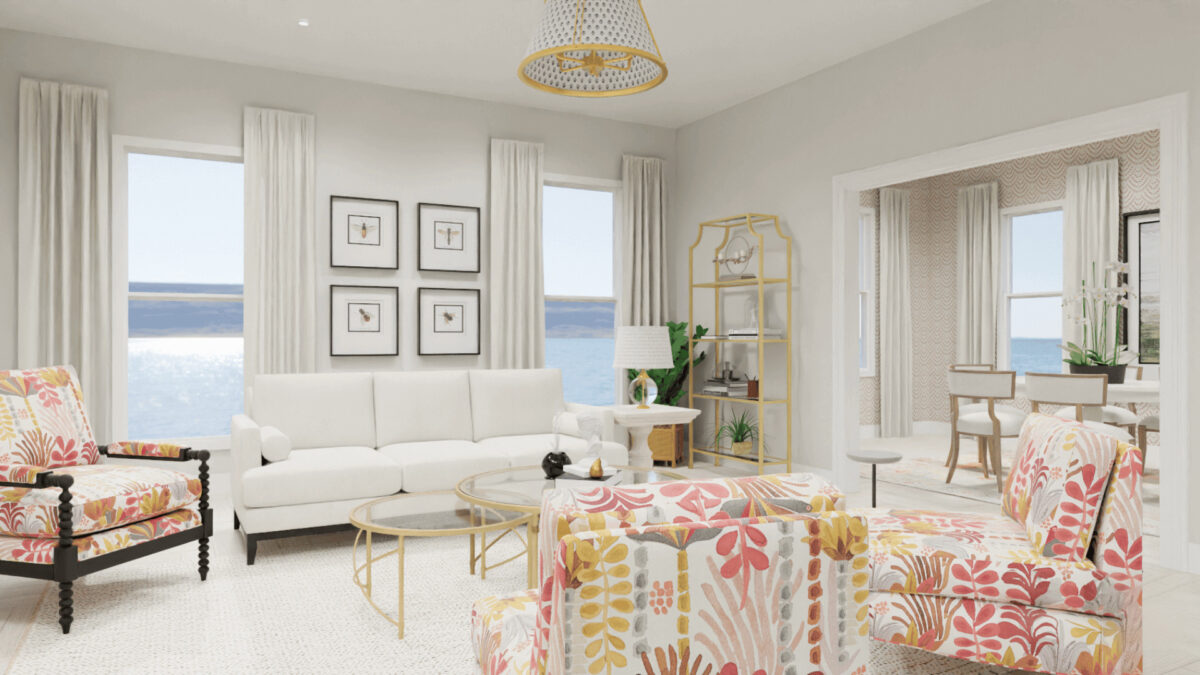
3D product merchandising is revolutionizing how people shop online, and the trend shows no signs of slowing. In this article, I draw on my 12+ years of experience in product visualization to share examples of 3D merchandising, explain why brands should invest in it, and show how it can improve sales.
Inside this article:
What is visual merchandising?
Visual merchandising is a way of presenting products in stores to attract more shoppers and grow sales. Displays should appeal to the five senses to build an emotional reaction. Everything from floor plans to lighting to color contributes to creating curated product displays.
If you’ve ever walked into a store and immediately felt attracted to a collection of related items, then you’ve experienced visual merchandising. For example, the Apple Store uses lighting to highlight products and white space to direct your path through the retail experience. You can find the results of the practice in displays, signs, window treatments, the checkout area, and groupings of three similar products. Or maybe you walk into a store selling vintage rock T-shirts and hear the store playing music from those bands. Even though music isn’t visual, we still consider it visual merchandising because it affects one of the five senses.
The marketing practice takes a great deal of planning and research to do well, but it’s well worth it. , found that stores lose up to 25% of retail sales due to poor execution. Good visual merchandising considers lighting, the physical retail space, color, data from brick-and-mortar stores and company websites, and a customer’s five senses. The final installment should reflect the brand, stay true to messaging, and use technology to create a more interactive experience.
What is 3D product merchandising?
3D product merchandising is an e-commerce technique. Companies use 3D models, AR, and VR to allow customers to see every angle of a product and interact with it online before purchasing. 3D product merchandising can grow sales and reduce returns.
3D product merchandising refers to building and using 3D models of products to sell online and is an integral part of 3D e-commerce. Visual merchandising in e-commerce and 3D merchandising are phrases that also describe 3D product merchandising. The practice involves creating 3D models for product configurators, websites, and AR and VR applications. The goal is to provide an immersive experience in marketing campaigns. The term can refer to 3D product merchandising to create visual content for marketing purposes. It is also used to describe the use of 3D design tools and data to create store layouts for brick-and-mortar locations.
Technologies used in 3D merchandising
The main technology used in 3D merchandising involves creating the 3D model. Once you have a model, you can use it in product configurators, AR, VR, and 3D renders.
The technologies for 3D product merchandising include:
- Computer-generated imagery (CGI) and 3D product images: 3D product merchandising starts with creating the images. Designers use 3D modeling software to create models of products or environments (such as a kitchen space or living room). They can also scan the actual product to use as the base of an image. Once they enter the basics into a system, designers add layers, lighting, and textures to build a realistic 3D version of the product.
- Product configurators: In this scenario, retailers use 3D product merchandising to enable customers to see different versions of their products online. Users can change the color or add or remove certain features. For example, with just a few clicks or taps, someone shopping for a car could see it with a different color and interior.
- AR applications: A popular use of 3D product merchandising in AR is enabling customers to see a product in their own space. For example, someone shopping for a couch could use AR to see how it would look in their home before purchasing. Companies can incorporate AR into an app or use WebAR, which uses a Web browser.
- VR uses: 3D product merchandising in VR lets people interact virtually with the product. VR solutions let customers “touch” and “feel” goods. For example, a customer considering buying a jumpsuit online actually “tries it on” without ever entering a dressing room.
- 3D renders: Companies use 3D renderings to build scenes or spaces where they place the 3D models. They use 3D renders as a sales and marketing tool.
Benefits of 3D product merchandising
The many benefits of 3D product merchandising include higher sales and fewer returns. 3D also helps you save on production costs and floor space in a physical store. When done correctly, it helps bring your brand to life.
Here are more details on the benefits of 3D product merchandising:
- Increased sales: While getting up and running with 3D e-commerce might take a little time, investing in 3D product merchandising can help your bottom line. According to the 2022 State of Online Shopper Sentiment report, 88% of those surveyed say high-quality product imagery is important when making online purchases.
- Fewer product returns: Returns cost time and money, so reducing them is key. While people shop online, having the best view of what they’re buying is vital, and 3D product merchandising offers that. Interactive 3D images enable consumers to view a product from all angles, instilling more confidence in the purchase. According to a Coresight Research report in February 2023 titled “CGI and 3D Product Imagery: The Future of Visual Merchandising in e-commerce,” 55% of brands and retailers said customers returned more than 10% of their products because the product visuals didn’t match the item they received.
When consumers return products, not only does that mean the retailer lost a sale, but it also comes with the additional labor costs of processing and restocking it. Sometimes the store needs to send the product back to the manufacturer.
- Show more inventory and choices than you could in a brick-and-mortar store: 3D configurators allow consumers to customize their desired products. They can change colors and swap out features. Large items like furniture and cars occupy a lot of space in the physical world, so showing different options for them isn’t always feasible or affordable. Additionally, companies benefit from using AR to create a virtual catalog. Customers can see more products than what’s on the floor and use AR rendering to see how it looks in a room.
- Improves customer engagement: When you give customers something to interact with, they will likely spend more time on your site. Beyond just offering customizations, 3D renderings and AR apps can engage customers more. In 2021, Shopify found that companies using 3D content experienced a 94% lift in conversion, on average. Shoppers want that option. A Nielsen IQ Survey found that 61% of shoppers prefer to shop with retailers that offer AR.
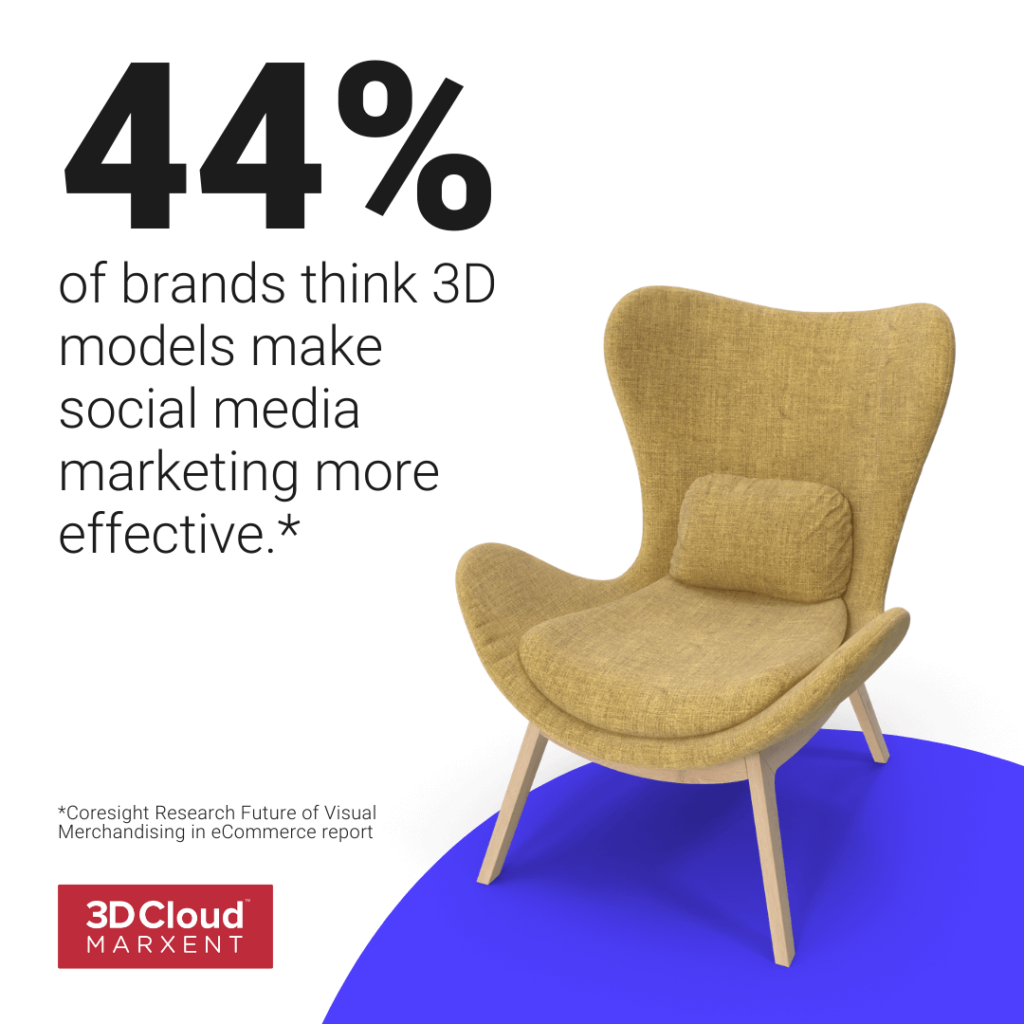
- Saves on production time: You no longer need to book and pay for expensive photoshoots to present the product differently, because 3D models are easy to configure, reuse and edit. Once you have an image, you can work with a 3D photography studio or use a 3D platform to easily convert it to just about any 3D file format you need for an online catalog, social media, marketing, or sales tool. In fact, Coresight Research found that 44% of brands think 3D models make social media marketing more effective.
- Better sustainability: Stores reduce their carbon footprint by reducing the products they keep on the sales floor and increasing their 3D product merchandising online. They can minimize product shipments to stores and only ship goods directly to customers. Coresight Research found that 39% of brands and retailers investing in CGI think it improves their carbon footprint —and many customers care about that. that 45% of consumers preferred to buy goods from companies with a clear commitment to sustainability.
- Sells a lifestyle: 3D images allow designers to do so much more. Designers can take a flat product, bring it to life with 3D animation, and place it in a setting that promotes a certain lifestyle. Imagine seeing a 3D hiking boot highlighted on a trail instead of against a white background. The image on the trail shows the life you could have if you bought the shoe. The 2022 State of Online Shopper Sentiment found placing an item in a lifestyle context was more likely to capture the attention of 60% of consumers when shopping online versus one on a plain white background.
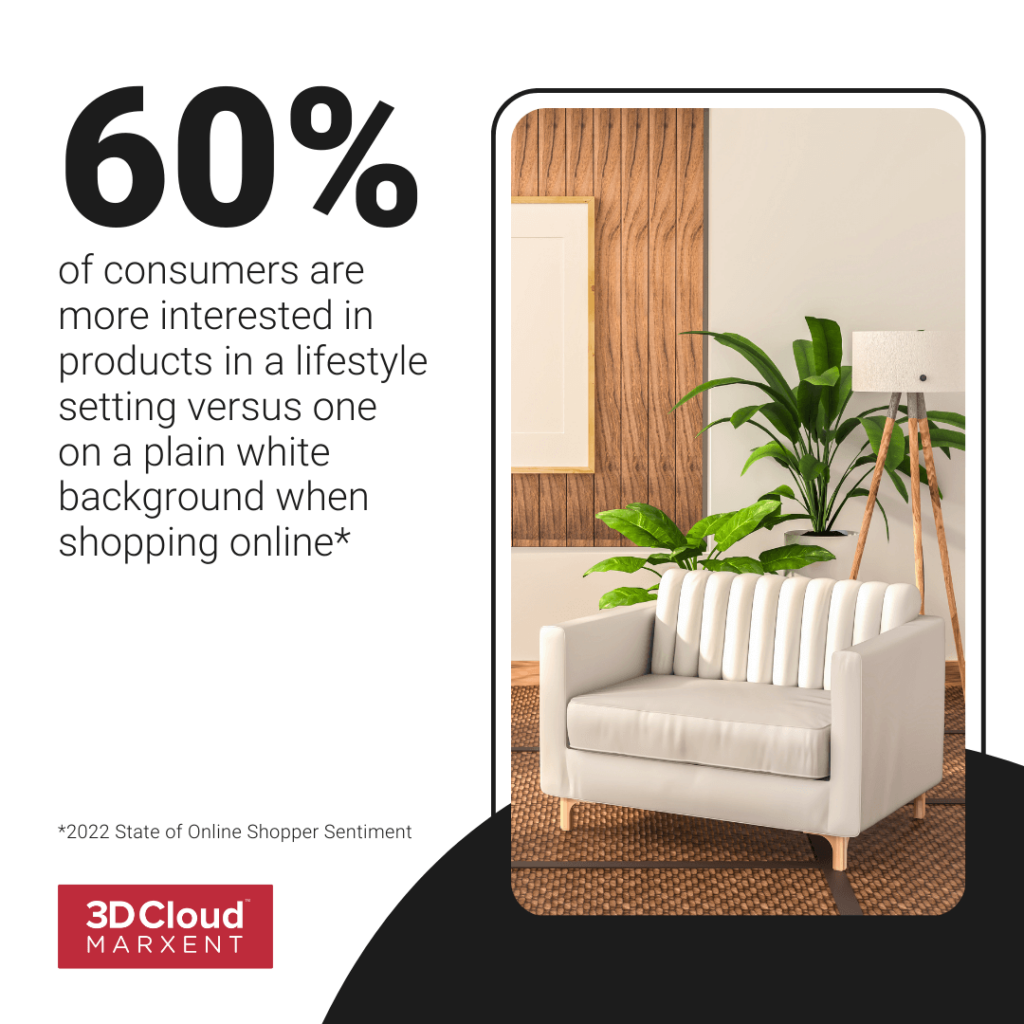
Examples of 3D product merchandising
You can find examples of 3D product merchandising all over the internet. Companies are designing spaces in real time with 3D renderings. Others are populating product pages with 3D images. Large retailers use VR to show even more offerings to customers.
Design Within Reach 3D rendering service
Design Within Reach, a high-end modern furniture company, has incorporated 3D product merchandising into their marketing efforts by using 3D lifestyle renders in their print catalog at times that DWR uses for in-house design services appointments. The 3D room planning tool lets designers create custom floorplans that are then populated with 3D products that reflect each unique order. When the room design is complete, it takes less than 2 minutes to produce a render. This helps the shopper to visualize what their custom furniture order will look before it arrives. This technology allows the user to visualize different ways they could plan a large, open space (as in the image below) or experiment with ways to get the most out of a smaller floorplan.
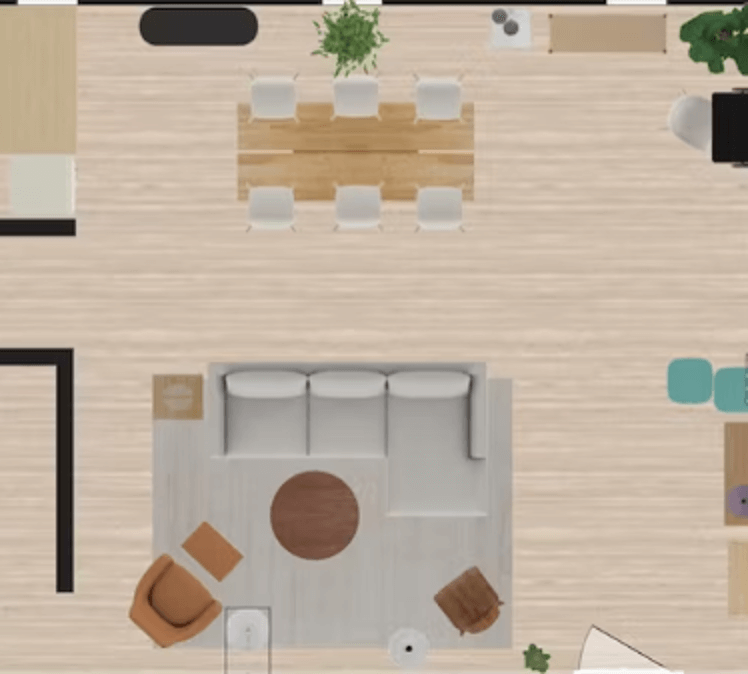
Popular lighting brand illuminates its lighting
Quoizel uses 3D renders to highlight its lighting products in a room. Customers can see how a lamp or chandelier looks in the context of a designed space.
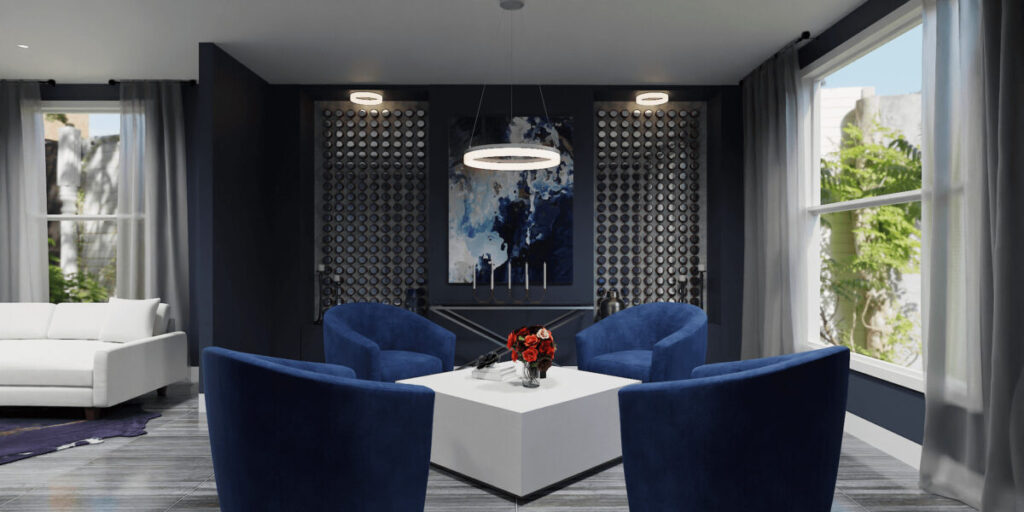
Macy’s delivers 3D shopping experiences
3D experiences are a growing trend in 3D product merchandising. Offering much more than static renderings, interactive 3D shopping experiences provide users the opportunity to use customize their purchases and then view them in Augmented Reality to view furniture in context and a 3D room planner for customizing a space with 3D products that reflect real furniture SKUs. Since the experience is virtual, the company can show double its inventory while saving on valuable floor space
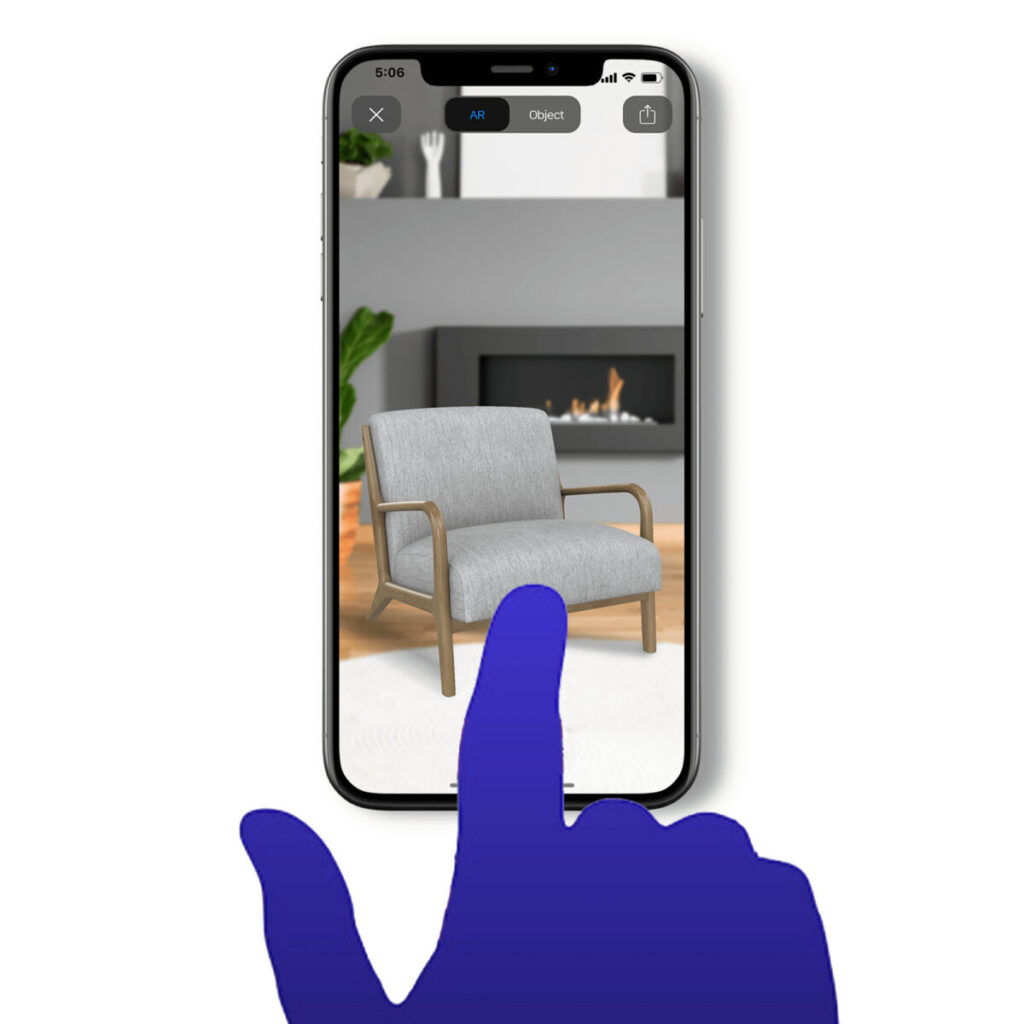
Bringing product pages to life with 3D images
Retailers use single product renders and 360 spins to produce stunning product page imagery so customers can view every angle of a product. Using 3D images, viewers can interact with the product, spin it around, change the color (if it’s available in another hue), and see it in a room. This chair example from La-Z-Boy Furniture shows how a retailer can use 3D product merchandising to bring configurable products to life. It’s possible to configure the chair in 3D with a 360-degree view, then view it in Augmented Reality on a mobile device.
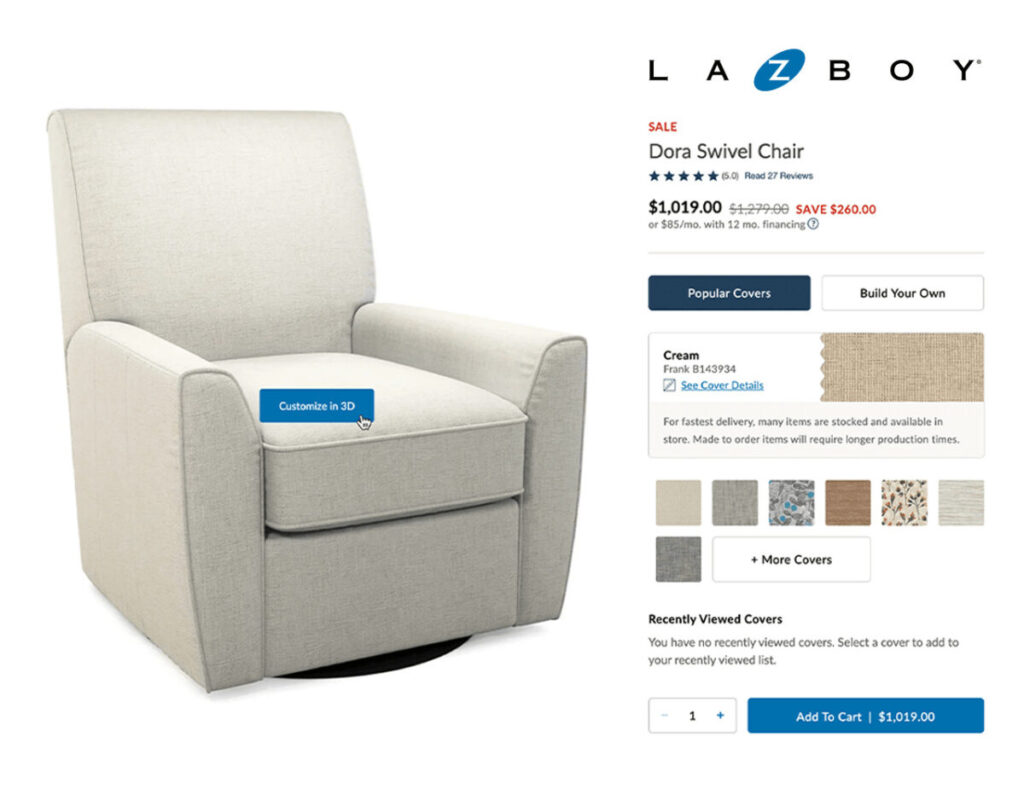
Challenges of 3D product merchandising
The 2023 Coresight Research report found that 65% of brands find it challenging to create 3D images and manage operations. The main issues they face are the initial cost, consistency, and incorporating it on their site.
These are some of the challenges that come with investing in 3D product merchandising:
- Expense: The initial set-up cost may be the biggest challenge companies face, especially small businesses. Getting started with 3D product renderings for an entire catalog can be cost-prohibitive. Coresight Research found that 43% of companies not investing in CGI say their reason is the high cost. However, that doesn’t have to be the case. Not all products benefit from 3D visualization, and they don’t need to be done all at once. Prioritize best sellers and highly configurable products.
- Technical know-how: The Coresight Research survey found another leading deterrent to starting with 3D product images is know-how. Forty-three percent of the brands said a lack of knowledge stopped them from doing it. Yet, there are vendors who do all the heavy lifting for companies and provide finished 3D images that are ready to publish.
- Integrating images into the existing site: It’s not just the technical knowledge to create the 3D products; it’s also what to do with the 3D products once you have them. If not correctly optimized, the image sizes can be huge and take a long time to load on a site, cutting into the benefits. Additionally, shopping sites built with legacy tools may not handle the images. Doing a technical audit of your site is important to ensure it can support the new 3D visuals and tools.
- Customer adoption: While many consumers are embracing and coming to expect 3D product visuals and experiences when shopping online, some will still have a learning curve and prefer to touch the product in a store. The Emarsys 2022 Customer Loyalty Index found that 54% of consumers still prefer to shop in-store.
- Intellectual property concerns: Intellectual property is not currently a big concern, but it could become more of an issue as 3D use cases and digital creative rights evolve in retail. The replication of actual products into digital versions could infringe on patent rights in the future. We may see more challenges when companies grow their e-commerce business in the metaverse.
Pros and cons of 3D product merchandising
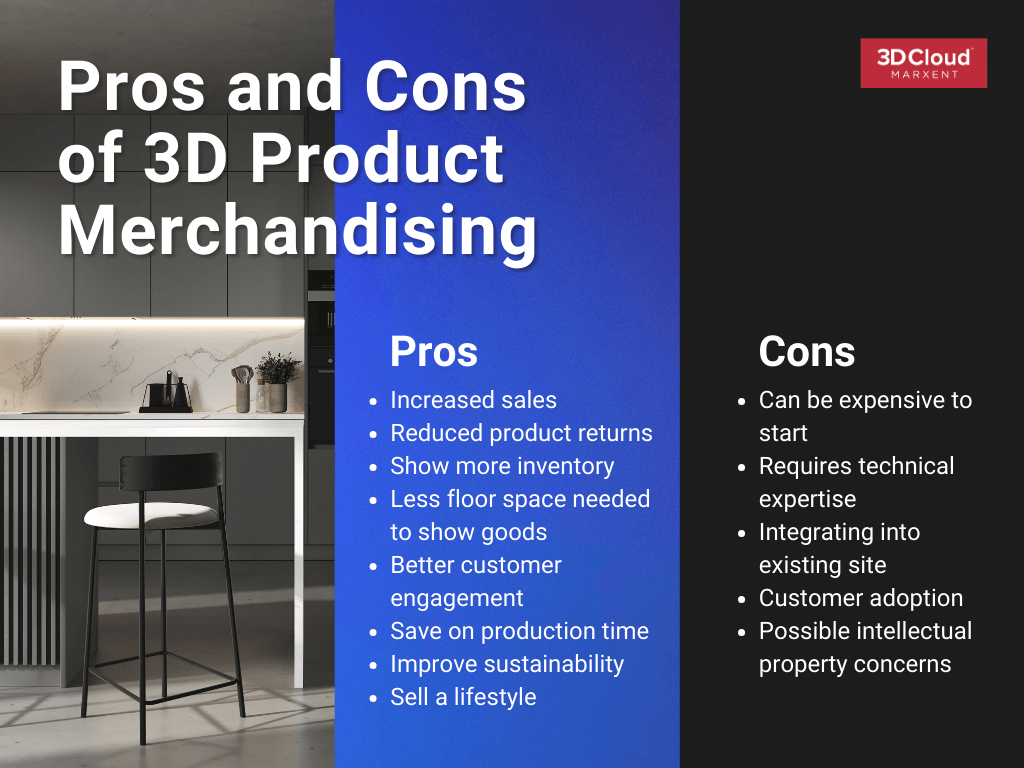
Future of 3D visual merchandising in e-commerce
The future of 3D visual merchandising in e-commerce is quite promising. As AI rolls out, it will make 3D merchandising even easier and more affordable. Additionally, AR and VR shopping applications will continue to grow, providing new ways to use 3D images.
“Combined with AI, 3D Technologies like and 3D product configuration will revolutionize the product page, making 3D product merchandising as commonplace as 2D product imagery is today,” said Beck Besecker, CEO and Co-Founder of 3D Cloud by Marxent. “We are seeing retailers adopt 3D merchandising strategies at record rates and expect robust growth in 3D product configuration, 3D renderings for photo replacement, and augmented reality,” Besecker said
As AI and machine learning (ML) evolve, they will streamline 3D product merchandising even more and break down the challenges companies face as they add this functionality to their sites. AI will automate some of the more time-intensive aspects of creating 3D products, accelerating model creation and reducing the overall cost of 3D content creation. We’re just beginning to see innovations in that area.
Retailers are intrigued by what AI can offer. Coresight Research found that 30% of retailers in their survey are already investing in AI to automate product visuals online, and 68% are planning to invest in AI to help automate creating product visuals.
How to choose a 3D product merchandising tool
Retailers looking to invest in 3D product merchandising should consider many of the same factors they would when buying other software or service solutions. They should also consider their initial and long-term needs.
When researching 3D product rendering tools, list your current needs and production timeframes, and consider if the job is a one-off or part of a long-term strategy. You should also document and prioritize the products or scenes that will be created and rendered. If cost is a barrier to entry, prioritize best sellers and start measuring the impact.
It’s also important to consider whether the solution can generate images in multiple file formats. If you plan to use 3D products and 3D product merchandising in AR or VR, verify that the relevant 3D file types are supported. And whatever plan you have for 3D product merchandising, ensure that it will be compatible with your existing systems.
Service and support are another top consideration. Ask what they include and if there’s any training. Are online tutorials and forums enough? Find out how long it might take to get started with the product. You can find even more helpful advice on what to look for in this article on building or buying a 3D product merchandising solution.
How to streamline 3D product merchandising
3D products help improve customer engagement and dwell time. They offer customers an endless stream of unique, low-cost interior scenes merchandised to meet marketing objectives.
With 3D Cloud by Marxent, you get an intuitive 3D product merchandising solution. Use it to easily create 3D visual merchandising that portrays engaging lifestyle content and photorealistic 3D renders for online product merchandising. Use the instant 3D online room renders you create to produce fresh content daily.
Deploy WebAR, 3D product configurators, and 3D room planners, and more from a single platform with 3D Cloud by Marxent. Scalable, secure, and proven, 3D Cloud is the enterprise platform of choice for leading furniture and home improvement retailers and manufacturers.












